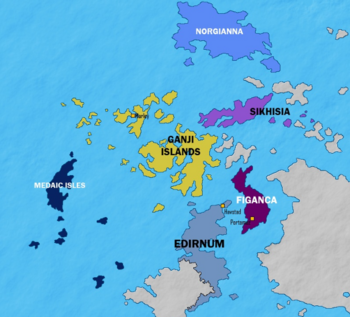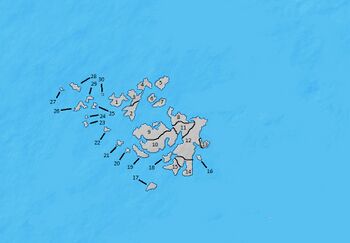Ganji Islands
This article is incomplete because it is pending further input from participants, or it is a work-in-progress by one author. Please comment on this article's talk page to share your input, comments and questions. Note: To contribute to this article, you may need to seek help from the author(s) of this page. |
Democratic Republic of Ganji Islands República Democrática das Ilhas Cânhami (Portuguese) Reçbuwlike Democrati das Ilhe Kwanji (kwiji) | |
|---|---|
Motto: Viver com cânha, família e Deus Live with ganja, family and God | |
Anthem: "Szwasa Deus na nozo paiç" | |
 | |
| Capital | Marley |
| Official languages | Portuguese, Kwiji, English |
| Recognised national languages | - Bwinu Minszesi Zawali Jeçein Cevi |
| Ethnic groups (2017) | 64,7 % Baji 25,2 % White 8,3 % Bwinu 3 % Zakawali 0,8 % Other |
| Religion (2017) | 44 % Christian 23 % None 19 % Rastafarian 14 % Other (Including Muslim, Jewish and Buddhist) |
| Demonym(s) | ganjian, giji, ganjaman |
| Government | |
• President | Eric Kofi Khélowaki |
• Vice President | Etienne Brekowantaz |
• Prime Minister | Tuakwa Jndzo |
| Legislature | Parliament |
| Formation | |
• Independence from | 28 May 1744 |
• Civil War | 19 June,1977 - 19 October 1988 |
• Reunification | 2 March 1994 |
| Area | |
• | 1,556,992 km2 (601,158 sq mi) |
| Population | |
• 2017 estimate | 17,700,748 |
• Density | 11.3/km2 (29.3/sq mi) |
| GDP (PPP) | estimate |
• Total | 844,7 billion USD |
• Per capita | 47,721 |
| Gini | 8 low |
| HDI (2017) | very high |
| Currency | gawresh (ɠ) (GWR) |
| Time zone | UTC+6 (EIT) |
| Date format | dd-mm-yyyy |
| Driving side | right |
| Calling code | +22 |
| Internet TLD | .gj |
 | |
Ganji Islands, (also known as Ganji or Kwanji) is a country in Anteria. The country got its independence from Sharkdonia in 1744.
History
125 AD (Foundation of Ganji)
18th century (The Three Tribes)
19th century (The Trebilam crisis)
The Trebilam Crisis caused the mass migration of about 700,000 Ganjians.
20th century (The Civil War)
21st century
Geography
Ganji is located in southern Anteria.
Ganji is known for its stunning nature, the forests and the beautiful mountains. The highest point in Ganji is the Njembwe Mountain (2,448 m) in South Ganjiland. The main rivers are the Lokombo River and the Jabulani River. Lokombo is the main water source for the mainlanders.
Regions
| № code |
Flag | Name | Population | Capital | Capital population |
|---|---|---|---|---|---|
| 1 | Marl Island | 7,700,000 | Marley | ||
| 2 | South Ganjiland | 800,000 | Cobewe | ||
| 3 | North Ganjiland | 800,000 | Portland | ||
| 4 | Johnston | 400,000 | Çeb | ||
| 5 | Bjawi | 200,000 | Limeno | ||
| 6 | Akiwa | 220,000 | Twane Kebwe | ||
| 7 | Swalale | 180,000 | Deschen | ||
| 8 | Yegrentez Valin | 400,000 | Raiyed | ||
| 9 | Herbington | 3,120,000 | Herbington City | ||
| 10 | Nuevo Lokombo | 240,000 | Berhine | ||
| 11 | Middleton | 120,000 | North-Amirtown | ||
| 12 | Kewze | 160,000 | South-Amirtown | ||
| 13 | Jahbi | 280,000 | Seatown | ||
| 14 | Goarpaz | 56,000 | Mount Cabela | ||
| 15 | Denver | 356,000 | Freetown | ||
| 16 | Njab Di Zawal | 58,000 | Zakadilébe | ||
| 17 | Banton Island | 88,000 | Buju Town | ||
| 18 | Demaruén Island | 48,000 | Casedis | ||
| 19 | Banana Island | 12,000 | Nebiné | ||
| 20 | St. Kap-Vau | 400,000 | Kap-Vau | ||
| 21 | St. Damién | 140,000 | Djewe | ||
| 22 | Kjaw | 90,000 | Kszedszinhebi | ||
| 23 | Cape Eter | 960,000 | Eter Town | ||
| 24 | Kantena | 50,000 | Fisher | ||
| 25 | Nevre | 25,000 | Nevre | ||
| 26 | Boomerang Island | 20,000 | Rixton | ||
| 27 | Gyu Na | 38,000 | East Bay | ||
| 28 | Ivelze | 120,000 | Carlsson | ||
| 29 | Hamilton | 200,000 | Fort Rajat | ||
| 30 | Bwinuéngde | 6,400 | Zwinak |
Culture
Music
Music is very popular in Ganji Islands. Cabonde Bay Music Festival is one of the most important events in there. It has been held since 1969.
Sports
Football is the most popular sport in Ganji Islands. Ganji has a professional men's national football team. They also have a professional football league, Ganji Football League.
Society
Demographics
| Population in Ganji | ||
|---|---|---|
| Year | Population | |
| 1700 | 2,195,346 | |
| 1800 | 5,065,034 | |
| 1900 | 9,217,328 | |
| 1980 | 13,980,232 | |
| 1990 | 12,445,521 | |
| 2007 | 16,259,401 | |
| 2017 | 17,700,748 | |

